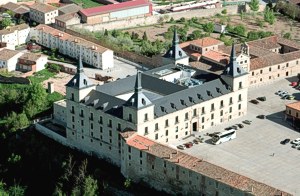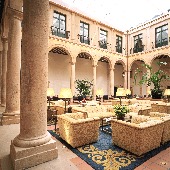
LERMA, Castile-Leon, SpainKing Felipe III would often come to stay with the Duke at his palace, and consequently the historic quarter has a more stately appearance than most. Perhaps the most impressive building in town however, is the 17th century Collegiate Church of San Pedro, which is connected to the Ducal Palace and overlooks the river. It may look rather austere on the outside, but inside it is quite beautiful, and contains the oldest organ in Spain. Amazingly the organ, which dates back to 1616, is still in fine working order and if you happen to be there in August you will have an opportunity to hear it played. For this is the time of year when all the Baroque festivals in Castile-Leon begin, and Lerma holds two organ concerts during the celebrations. In the Plaza Mayor, they also put on a 17th century theatre performance as well as several other medieval celebrations. Another very special time to visit is in September, when their local festival takes place. This includes a fairground with lots of rides and music all located close to the Ducal Palace. 
Other sites worth exploring are the 10th century Torre de Dona Urraca built to defend the town, and the Arch of Carcel, the gate to the medieval wall that the Duke had converted into a prison. There are also three Monasteries; the San Blas, Madre de Dios, and La Ascension de Nuestra Senora, all dating back to the Dukeís era. Because Lerma is approximately 200km from the nearest airport and the train station is 36 kms away, hiring a car is very much a necessity. However, that also gives you the freedom to explore the surrounding area, such as the town of La Piedad, the dramatic La Yecla Gorge, and the Monastery of Santo Domingo de Silos where you can hear the monks singing Gregorian chants. Also beyond Lerma is the town of Covarrubias. The entrance to the old quarter is through an arch decorated with King Felipe IIís coat of arms on the facade. The houses within the historical part are typical of Castilian architecture and the best example of this would be the house of Dona Sancha. They have a ground floor made of stone, with a wooden framework and balconies that are continuous. While you are there be sure to look for the 12th century Church of Santo Tomas, and the15th century Church of San Cosme y San Damian where the tombs of their most illustrious families rest beneath the Altar. Particularly interesting is that one of the wives of the nobleman was buried in a 4th century Spanish-Roman sarcophagus. If you are interested in religious artwork of that period, there is an exhibit in a small museum inside the church. The Covarrubias Parish Museum has two very special exhibits as well; the Calahorra Parish Cross and the triptych of Magi. There are also some scriptures that were written between the 15th and 18th century. If you are looking for a base while you are in Lerma, the Palace has been converted into the Parador Lerma (Hotel Palacio Ducal de Lerma) offering elegant accommodation and superb cuisine. With the Lerma Golf Course only 5km, it is also the perfect place to stay for any golf enthusiasts. |